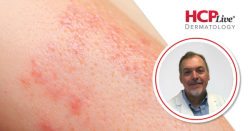
OR WAIT null SECS
Perfluorohexyloctane Delivers Rapid Dry Eye Relief, With Jason Bacharach, MD
A new study highlights rapid relief and high satisfaction with PFHO for dry eye disease, showing significant symptom improvement within minutes.
A recent phase 4, multicenter, open-label study identified rapid and sustained relief with perfluorohexyloctane ophthalmic solution (PFHO; MIEBO) in symptomatic patients with dry eye disease (DED).
Presented at the 2025 American Society of Cataract and Refractive Surgery (ASCRS) Annual Meeting, these data observed significant symptom reduction within minutes of administration and high levels of patient satisfaction maintained throughout the 14-day study period.
“At five minutes after the first dose, [we observed] a significant improvement in a variety of symptoms and the total composite dry eye symptom improvement score on the Visual Analogue Scale (VAS) was so large, almost 50% after one dose,” Jason Bacharach, MD, director of research at North Bay Eye Associates, told HCPLive. “That symptom score continued to improve at every time point measured over the first 14 days. This was one of the first studies ever conducted at our research center, looking at improvement five minutes after dosing.”
The trial enrolled 99 adults with a history of DED, all of whom instilled PFHO in both eyes four times daily. Patients completed early outcome surveys on days 1 (baseline), 3, 7, and 14 clinic visits, which assessed DED symptom severity (overall and 8 symptoms) and treatment satisfaction (VAS, 0-100).
At baseline, participants reported a mean tear film breakup time of 3.6 seconds and moderate to severe meibomian gland dysfunction. The primary endpoint—mean change in overall DED symptom severity at Day 7—was statistically significant, with a 61.7% reduction (P <.0001). Improvements were consistent across all time points and extended across the individual symptom domains, including dryness, burning, irritation, and blurred vision.
The study revealed high treatment satisfaction scores, with a median rating of 83.0 at Day 3, 86.0 at Day 7, and 90.0 at Day 14. Bacharach indicated this could support improved treatment adherence for patients with DED.
“If patients are happy with the therapy, whatever that therapy is, they're more prone to stay on, improving adherence,” Bacharach told HCPLive. “That’s what I have found clinically in my practice. People using PFHO really want to stay on the drop, and that is a huge benefit.”
Dr. Bacharach noted that PFHO’s physical properties contribute to its fast action, noting its small size allows it to stay on the ocular surface and create a barrier at the air-tear film interface.
“We think that because of its ability to create a barrier at the air tear film, particularly lipid level interface, the patients develop a significant improvement early on and then maintain an improvement until their next dosing,” Bacharach told HCPLive. “It reduces evaporation on the front of the eye, with patient satisfaction rising as early as day three.”
Relevant disclosures for Bacharach include Allergan, Bausch + Lomb, EyePoint, Injectsense, Insite, Ocular Therapeutix, and others.


